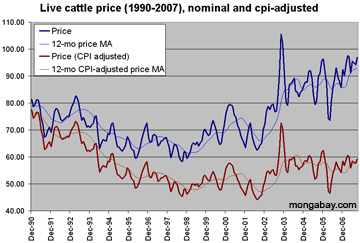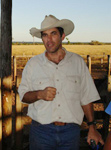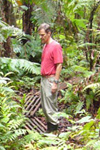Amazon beef producer creates eco-certified meat product with help of scientists
Amazon beef producer creates eco-certified meat product with help of scientists
mongabay.com
June 8, 2008
|
|
Independencia Alimentos SA, Brazil’s fifth-largest beef producer, will create an “eco-certified”, branded beef product from the Amazon’s Xingu region.
Certification will be based on criteria established by Aliança da Terra, an Brazilian NGO that seeks to improve the environmental performance of ranchers and beef producers in the world’s largest rainforest. The new beef product will include a per-kilo “ecosystem service fee” — calculated with the help of scientists at the Woods Hole Research Center — to facilitate a financial reward for the producer’s environmental stewardship.
“This brand will distinguish good land stewards from those who are simply tearing down the Amazon rainforest without regard for the environmental impact,” said John Cain Carter, founder and president of Aliança da Terra. “Independencia is actively marketing the idea in Europe and, if successful, will be a landmark product for the Amazon.”
Carter argues that the only way to slow deforestation in the Amazon — increasingly linked to beef and grain prices — is to offer producers financial incentives for environmental performance. In a region where laws are irregularly enforced, archaic land titling and rampant corruption, Aliança da Terra is pioneering a way to recognize land owners who do follow environmental regulations, including leaving at least half their land forested, protecting riparian zones, reducing erosion by restricting livestock from waterways, and eliminating the use of fire.
“We want market recognition for shouldering this conservation burden,” Carter told mongabay.com. “Where else in the world do you have landowners who have to keep 50 percent of their land forest? Nowhere. As it is right now there’s nothing to keep forest standing because the law doesn’t catch you in time and you can always bribe your way out of it if you do get caught.”
 |
“We’re trying to turn this forest reserve law from a negative into a positive,” he explained. “People think farmers in the Amazon are bandits so we’re trying to show there are good people who are trying to make a difference and reduce their impact… We’re turning the system on its head, adding transparency and credibility to turn it into a worldwide example of good land stewardship. Producers will be rewarded through market acceptance for taking the extra steps to do the right thing. They’ll be able to take their product to McDonalds, Burger King, and other firms worried about reputations. All the big multinationals want credibility these days in regards to the environment and sustainability.”
“We offer consumers confidence instilled by the involvement of impeccable organizations,” he continued. “We have some of the top naturalists and environmental scientists in the Amazon involved with this.”
Clearing for cattle pasture is the largest driver of deforestation in the Amazon, accounting for more than two-thirds of annual forest clearing in some years. Traditionally such land has been used for low intensity grazing, primarily as a vehicle for speculating on appreciating land prices, but this is changing. The recent influx of capital, combined with the eradication of foot-and-mouth disease and improved infrastructure, has lead to the emergence of intensive operations with six to eight times the number of cattle per hectare.

Influence of live cattle prices (CPI-adjusted, 12-month moving average) on deforestation in the Brazilian Amazon. While nearly two-thirds of Amazon clearing can be attributed to conversion for cattle pasture, deforestation in the states of Mato Grosso and Para has shown a only a slight correlation to cattle prices in recent years. This could be due, in part, to the use of cattle pasture for land speculation (land prices are rising faster than the value of cattle) and as a hedge against inflation and currency fluctuation. All figures in hectares (2.47 acres).
Related articles
Land invasions undermine Amazon forest law (April 3, 2008)
Land invasions are undermining a Brazilian law that requires ranchers to keep 80 percent of their land forested, according to reports from the Amazon state of Mato Grosso. A run up in land prices, driven by surging soy and cattle production in the region, combined with a lackadaisical response from law enforcement authorities are blamed for the incursions.
Cheap ranch loans may be driving jump in Amazon deforestation (February 12, 2008)
Surging deforestation in the Brazilian Amazon may be partly the result of new financial incentives given by state banks such as the Bank of Amazon (BASA), reports Agência de Noticias da Amazônia, a Brazilian newspaper, and the International Tropical Timber Organization (ITTO). In March the International Finance Corporation (IFC), the private equity lender of the World Bank, announced a $90 million loan to the Bertin Group for an “ecological” meat-packing facility in Marabá in Para. While some environmentalists criticized the deal, a leading expert on the Amazon said that it could play a key part in improving environmental compliance in the region.
Related interviews

|
John Cain Carter, founder of Brazilian NGO Aliança da Terra Cattle ranchers and soy farmers could save the Amazon — 06/06/2007 John Cain Carter, a Texas rancher who moved to the the Brazilian state of Mato Grosso 11 years ago and founded what is perhaps the most innovative organization working in the Amazon, Aliança da Terra, believes the only way to save the Amazon is through the market. Carter says that by giving producers incentives to reduce their impact on the forest, the market can succeed where conservation efforts have failed. What is most remarkable about Aliança’s system is that it has the potential to be applied to any commodity anywhere in the world. That means palm oil in Borneo could be certified just as easily as sugar cane in Brazil or sheep in New Zealand. By addressing the supply chain, tracing agricultural products back to the specific fields where they were produced, the system offers perhaps the best market-based solution to combating deforestation. Combining these approaches with large-scale land conservation and scientific research offers what may be the best hope for saving the Amazon. |
 |
Dr. Daniel Nepstad, Director of the Woods Hole Research Center’s Amazon program Amazon rainforest at a tipping point but globalization could help save it — 06/04/2007 The Amazon basin is home to the world’s largest rainforest, an ecosystem that supports perhaps 30 percent of the world’s terrestrial species, stores vast amounts of carbon, and exerts considerable influence on global weather patterns and climate. Few would dispute that it is one of the planet’s most important landscapes. Despite its scale the Amazon is also one of the fastest changing ecosystems, largely as a result of human activities, including deforestation, forest fires, and, increasingly, climate change. Few people understand these impacts better than Dr. Daniel Nepstad, one of the world’s foremost experts on the Amazon rainforest. Now head of the Woods Hole Research Center’s Amazon program in Belém, Brazil, Nepstad has spent more than 23 years in the Amazon, studying subjects ranging from forest fires and forest management policy to sustainable development. Nepstad says the Amazon is presently at a point unlike any he’s ever seen, one where there are unparalleled risks and opportunities. While he’s hopeful about some of the trends, he knows the Amazon faces difficult and immediate challenges. |